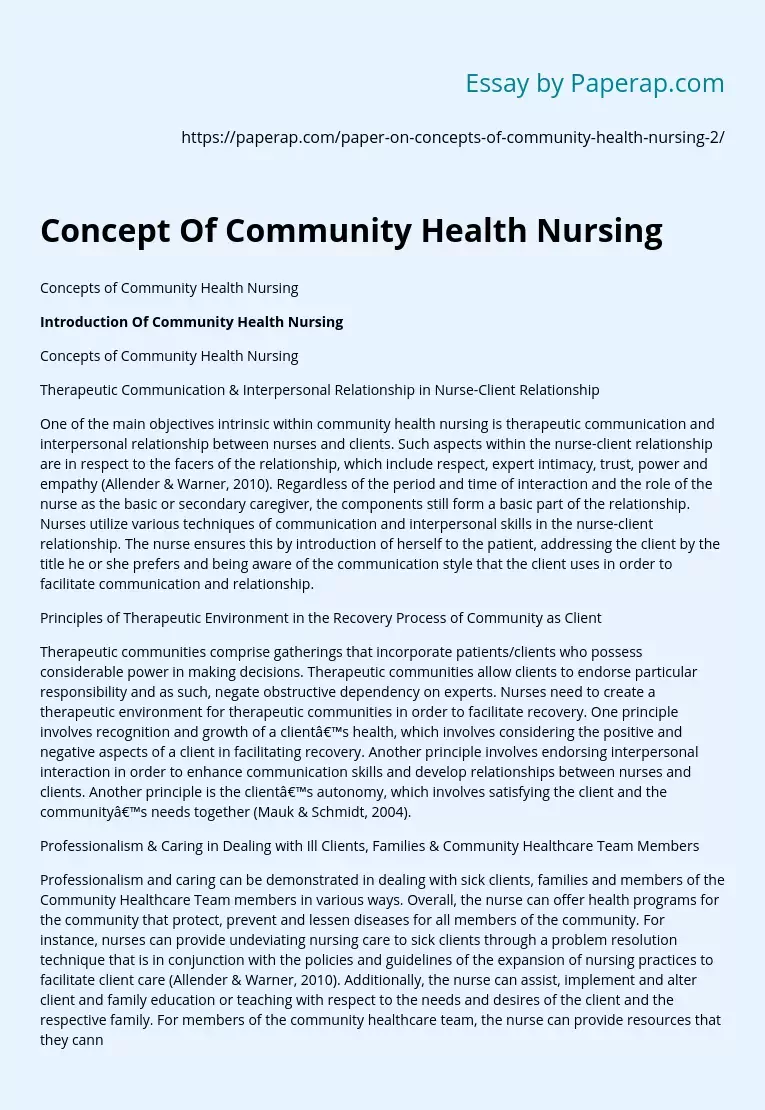Concept Of Community Health Nursing
Concepts of Community Health Nursing
Introduction Of Community Health Nursing
Concepts of Community Health Nursing
Therapeutic Communication & Interpersonal Relationship in Nurse-Client Relationship
One of the main objectives intrinsic within community health nursing is therapeutic communication and interpersonal relationship between nurses and clients.
Such aspects within the nurse-client relationship are in respect to the facers of the relationship, which include respect, expert intimacy, trust, power and empathy (Allender & Warner, 2010). Regardless of the period and time of interaction and the role of the nurse as the basic or secondary caregiver, the components still form a basic part of the relationship.
Nurses utilize various techniques of communication and interpersonal skills in the nurse-client relationship. The nurse ensures this by introduction of herself to the patient, addressing the client by the title he or she prefers and being aware of the communication style that the client uses in order to facilitate communication and relationship.
Principles of Therapeutic Environment in the Recovery Process of Community as Client
Therapeutic communities comprise gatherings that incorporate patients/clients who possess considerable power in making decisions.
Therapeutic communities allow clients to endorse particular responsibility and as such, negate obstructive dependency on experts. Nurses need to create a therapeutic environment for therapeutic communities in order to facilitate recovery. One principle involves recognition and growth of a client’s health, which involves considering the positive and negative aspects of a client in facilitating recovery. Another principle involves endorsing interpersonal interaction in order to enhance communication skills and develop relationships between nurses and clients. Another principle is the client’s autonomy, which involves satisfying the client and the community’s needs together (Mauk & Schmidt, 2004).
Professionalism & Caring in Dealing with Ill Clients, Families & Community Healthcare Team Members
Professionalism and caring can be demonstrated in dealing with sick clients, families and members of the Community Healthcare Team members in various ways. Overall, the nurse can offer health programs for the community that protect, prevent and lessen diseases for all members of the community. For instance, nurses can provide undeviating nursing care to sick clients through a problem resolution technique that is in conjunction with the policies and guidelines of the expansion of nursing practices to facilitate client care (Allender & Warner, 2010). Additionally, the nurse can assist, implement and alter client and family education or teaching with respect to the needs and desires of the client and the respective family. For members of the community healthcare team, the nurse can provide resources that they cannot acquire.
Legal and Ethical Principles in Dealing with Clients and Families of Various Cultural Backgrounds and Community Healthcare Team Members
Nurses are tasked with application of ethical and legal principles to different healthcare stakeholders. For clients, nurses are required to value and protect the integrity and welfare of the patient consistently. As such, nurses must revere the human dignity in each client regardless of their background (Mauk & Schmidt, 2004). For families with diverse cultural backgrounds, nurses must make sure that they respect the consent of families in advocating for procedures such as transplants in case the patient is deceased. In addition, nurses must ensure that they treat all persons with equality regardless of their different cultures.
Critical thinking skills and evidence–based practice while utilizing nursing process to provide holistic care to the ill and their families at various stages of the life cycle
Nurses require application of critical thinking and practice in the provision of care to patients in order to improve healthcare. As such, nurses can integrate critical thinking skills by questioning the information they receive regarding matters such as clinical situations. Furthermore, using clinical situations as an example, nurses can integrate the interpretation of situations involving patients by recognizing the deviating needs of the patient and family and using such evidence to create interventions based on the situation for mitigation.
Concepts of community health education in teaching clients and families throughout the Wellness-Illness Continuum
Throughout the Wellness-Illness Continuum, nurses can utilize concepts of community health education in order to facilitate education. For instance, nurses can ensure that they determine the cognitive processes of the learners in order to determine the techniques that they will implement in the continuum. More importantly, nurses can integrate educational techniques such as multimedia applications in the specific continuum in order to facilitate education for both patients and families.
References
Allender, J. A. & Warner, K.D. (2010). Community health nursing: promoting and protecting the public’s health. Philadelphia: Lippincott Williams and Williams
Mauk, Kristen L., & Schmidt, N. K. (2004). Spiritual Care in Nursing Practice. Philadelphia: Lippincott Williams and Williams.
Concept Of Community Health Nursing. (2019, Dec 05). Retrieved from https://paperap.com/paper-on-concepts-of-community-health-nursing-2/

